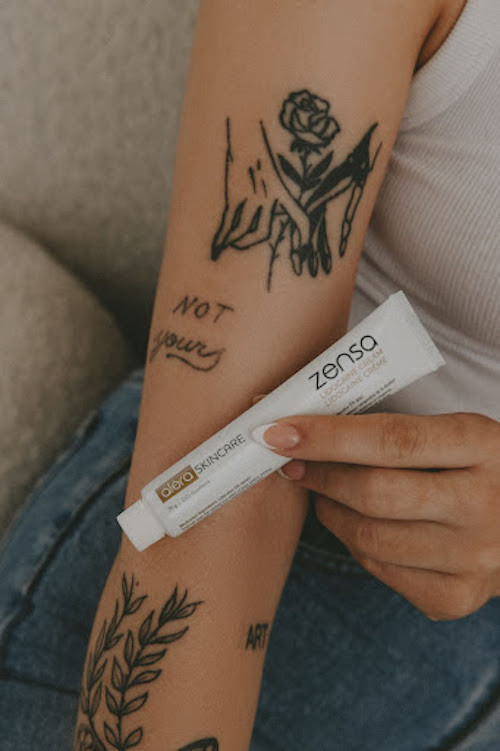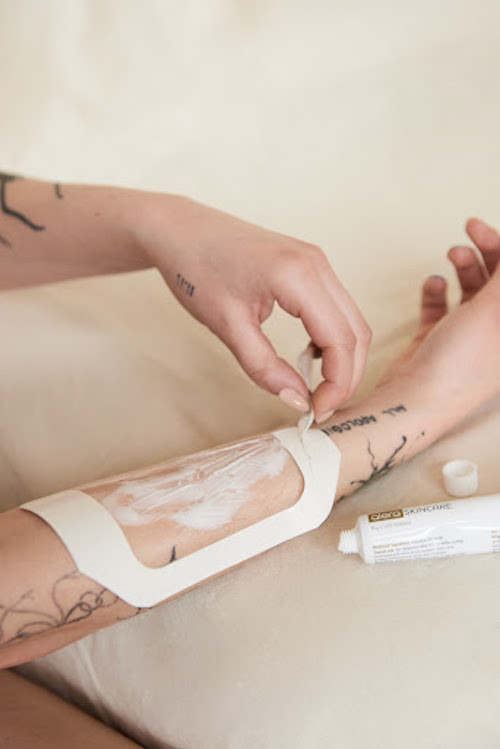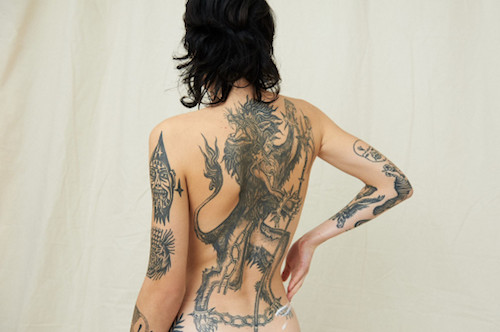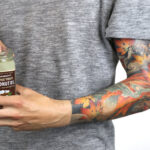Are Rib Tattoos Painful? Yes, rib tattoos are known to be one of the more painful tattoo placements due to the thin skin, proximity to bone, and nerve endings in the area; but at tattooat.com, we believe that understanding the experience can empower you to make informed decisions and find ways to minimize discomfort. Beyond the pain, rib tattoos offer a unique canvas for stunning designs, allowing for self-expression and creativity; you can learn more about pain management, aftercare tips, and find inspiration for your next tattoo, including design ideas, pain scales, and testimonials.
1. Understanding Tattoo Pain and Rib Tattoos
Tattoo pain is subjective and varies greatly from person to person, but rib tattoos are commonly regarded as one of the most painful locations, although factors such as individual pain tolerance, tattoo size, and artist technique also play a significant role. The rib cage has thin skin, minimal fat, and bone proximity, leading to higher sensitivity.
1.1 Why Rib Tattoos Hurt More
The rib cage area is known to be particularly sensitive due to several anatomical factors:
- Thin Skin: The skin over the ribs is thinner than in other body areas, making nerve endings closer to the surface.
- Bone Proximity: The lack of muscle and fat between the skin and bone means less cushioning, causing needle vibrations against the bone.
- Nerve Endings: The rib cage is densely populated with nerve endings, intensifying the sensation of pain.
- Breathing: The expansion and contraction of the rib cage during breathing can add to the discomfort during the tattooing process.
1.2 Factors Influencing Tattoo Pain
Several factors can influence the overall pain experience of getting a rib tattoo:
- Individual Pain Tolerance: Pain tolerance varies from person to person; some people naturally have a higher threshold for pain.
- Mental State: Anxiety and stress can heighten pain perception; relaxation techniques can help.
- Tattoo Size and Design: Larger, more intricate designs require longer sessions, increasing pain.
- Artist’s Technique: An experienced artist can minimize pain by using precise and efficient techniques.
- Skin Hydration: Well-hydrated skin is more pliable and less sensitive to the needle.
- Numbing Agents: Topical numbing creams can significantly reduce pain during the procedure.
 Rib Tattoo Placement
Rib Tattoo Placement
This image shows areas of the body that are most sensitive to pain during the tattoo process; the rib cage, where the skin is thin and there is little fat, is among the most sensitive.
2. Rib Tattoo Pain Scale: What to Expect
Rib tattoos typically rank high on the tattoo pain scale, often between 7 and 9 out of 10, but understanding the pain scale can help you mentally prepare and manage expectations, making the experience more manageable. The pain is often described as sharp, burning, and intense, especially during long sessions.
2.1 Understanding the Pain Scale
The tattoo pain scale is a subjective measure used to rate the level of discomfort experienced during tattooing:
- 1-3: Mild pain, like a light scratching sensation.
- 4-6: Moderate pain, similar to a sunburn or continuous scratching.
- 7-9: Intense pain, sharp and burning, often described as bone-on-bone sensation.
- 10: Excruciating pain, often unbearable for extended periods.
2.2 What Makes Rib Tattoos Rank High
Rib tattoos rank high on the pain scale due to the anatomical factors mentioned earlier:
- Bone Proximity: The needle’s vibration against the ribs intensifies the pain.
- Thin Skin: Less skin and fat cushioning means more sensitivity.
- Nerve Concentration: The high concentration of nerve endings amplifies the pain signals.
2.3 Comparing Rib Tattoo Pain to Other Areas
Compared to less painful areas like the outer thigh or forearm, rib tattoos are significantly more painful:
- Outer Thigh: This area has more muscle and fat, providing cushioning and fewer nerve endings.
- Forearm: The skin is thicker, and there are fewer bony prominences.
- Upper Back: More muscle and thicker skin reduce the intensity of the pain.
3. Male vs. Female: Does Gender Affect Rib Tattoo Pain?
While pain perception is individual, some differences exist in how men and women experience rib tattoo pain, but factors such as bone structure, fat distribution, and hormonal differences can influence pain sensitivity. Understanding these gender-specific differences can help manage expectations and prepare accordingly.
3.1 Anatomical Differences
Men and women have different anatomical structures that can influence pain perception:
- Bone Structure: Men tend to have denser bones, which can increase the sensation of vibration and pain.
- Fat Distribution: Women often have more fat around the rib cage, potentially providing some cushioning.
- Hormonal Differences: Hormonal fluctuations in women can affect pain sensitivity.
3.2 Perceived Pain Levels
Some studies and anecdotal evidence suggest variations in pain perception between genders:
- Women: May report higher initial pain levels due to hormonal factors and sensitivity.
- Men: May experience more intense pain due to denser bone structure and lower fat cushioning.
3.3 Expert Opinions
Tattoo artists often note that both men and women find rib tattoos highly painful:
- Artists: Emphasize that pain tolerance varies, but rib tattoos are consistently challenging for both genders.
4. Preparing for a Rib Tattoo: Minimizing Pain
Proper preparation can significantly reduce pain and improve the overall tattoo experience, and strategies such as mental preparation, skincare, and using numbing agents can make the process more manageable. Here are some effective ways to minimize pain when getting a rib tattoo:
4.1 Mental Preparation
Mental preparation is crucial for managing pain:
- Understand the Process: Knowing what to expect can reduce anxiety.
- Set Realistic Expectations: Accept that it will be painful but manageable.
- Use Relaxation Techniques: Practice deep breathing, meditation, or visualization.
- Distraction: Listen to music, podcasts, or engage in conversation.
4.2 Physical Preparation
Physical preparation can also help minimize pain:
- Stay Hydrated: Drink plenty of water in the days leading up to your appointment.
- Avoid Alcohol and Caffeine: These can increase sensitivity and anxiety.
- Get Enough Sleep: Being well-rested improves pain tolerance.
- Eat a Good Meal: A full stomach helps stabilize blood sugar levels.
- Wear Comfortable Clothing: Loose clothing prevents irritation around the tattoo area.
4.3 Skincare
Proper skincare can improve skin pliability and reduce sensitivity:
- Moisturize: Keep the skin well-moisturized in the weeks before your appointment.
- Exfoliate: Gently exfoliate to remove dead skin cells, improving ink absorption.
- Avoid Sunburn: Sunburned skin is more sensitive and can make the tattoo process more painful.
4.4 Numbing Agents
Topical numbing creams can significantly reduce pain:
- Lidocaine Creams: Creams containing lidocaine can numb the skin for several hours.
- Application: Apply the cream 30-45 minutes before the appointment and cover with plastic wrap.
- Consult with Your Artist: Ensure the artist approves the use of numbing creams.
- Zensa Numbing Cream: Zensa Numbing Cream contains 5% lidocaine for maximum-strength pain prevention without compromising pigment retention and does not contain any vasoconstrictors, so it will not temporarily change your skin’s texture or negatively affect ink settling.
 Woman Applying Skincare
Woman Applying Skincare
Proper skin care, including moisturizing and exfoliating, can help minimize pain when getting a rib tattoo.
5. Pain Management During the Tattoo Session
Effective pain management during the tattoo session can make the experience more bearable, and techniques such as communication with the artist, breathing exercises, and taking breaks can help you stay comfortable. Open communication and relaxation techniques are essential.
5.1 Communication with Your Artist
Clear communication with your artist is crucial:
- Express Concerns: Let your artist know if you are feeling too much pain.
- Ask for Breaks: Don’t hesitate to request short breaks to regroup.
- Discuss Numbing Options: Talk about using numbing sprays or creams during the session.
5.2 Breathing Techniques
Breathing exercises can help manage pain and anxiety:
- Deep Breathing: Inhale deeply through your nose, hold for a few seconds, and exhale slowly through your mouth.
- Rhythmic Breathing: Focus on maintaining a steady, rhythmic breathing pattern.
5.3 Taking Breaks
Regular breaks can provide relief and reduce overall pain:
- Short Intervals: Request a break every hour or as needed.
- Stretch and Move: Use breaks to stretch your body and improve circulation.
5.4 Distraction Techniques
Distraction can divert your attention from the pain:
- Listen to Music: Bring headphones and listen to your favorite playlist.
- Watch Videos: If possible, watch a movie or TV show on your phone or tablet.
- Engage in Conversation: Talk to your artist or bring a friend for support.
6. Aftercare for Rib Tattoos: Managing Post-Tattoo Pain
Proper aftercare is essential for healing and managing post-tattoo pain; following your artist’s instructions, keeping the area clean, and using pain relief methods can promote healing and prevent infection. Here are effective strategies for managing pain after getting a rib tattoo:
6.1 Following Artist’s Instructions
Adhering to your artist’s aftercare instructions is crucial:
- Cleaning: Gently wash the tattoo with mild soap and water.
- Moisturizing: Apply a thin layer of recommended ointment or lotion.
- Bandaging: Keep the tattoo bandaged for the first few hours or days, as advised.
6.2 Keeping the Area Clean
Maintaining cleanliness prevents infection and promotes healing:
- Wash Regularly: Clean the tattoo 2-3 times a day.
- Avoid Harsh Soaps: Use mild, fragrance-free soap.
- Pat Dry: Gently pat the area dry with a clean towel.
6.3 Moisturizing
Moisturizing keeps the skin hydrated and prevents cracking:
- Use Recommended Ointments: Apply ointments like Aquaphor or specialized tattoo balms.
- Thin Layer: Apply a thin layer to avoid suffocating the skin.
- Regular Application: Moisturize several times a day, especially after washing.
6.4 Pain Relief Methods
Various methods can help alleviate post-tattoo pain:
- Over-the-Counter Pain Relievers: Take ibuprofen or acetaminophen as directed.
- Cold Compress: Apply a cold compress to reduce swelling and pain.
- Loose Clothing: Wear loose-fitting clothes to avoid irritation.
- Avoid Direct Pressure: Try to avoid sleeping directly on the tattoo.
6.5 Recognizing Signs of Infection
Being vigilant for signs of infection is crucial:
- Excessive Redness: Increased redness around the tattoo.
- Swelling: Significant swelling or puffiness.
- Pus or Drainage: Any discharge from the tattoo.
- Fever: Elevated body temperature.
- Increased Pain: Worsening pain despite aftercare efforts.
- Seek Medical Attention: Consult a doctor if you suspect an infection.
7. Tattoo Numbing Creams: A Detailed Look
Tattoo numbing creams can be a game-changer for pain management, but understanding their benefits, ingredients, application, and potential drawbacks is essential for safe and effective use; you can significantly reduce pain by choosing the right product and using it correctly.
7.1 How Numbing Creams Work
Numbing creams work by blocking nerve signals in the applied area:
- Active Ingredients: Lidocaine, tetracaine, and prilocaine are common numbing agents.
- Mechanism: These ingredients prevent nerve endings from transmitting pain signals to the brain.
- Temporary Effect: The numbing effect is temporary and typically lasts for 1-3 hours.
7.2 Benefits of Using Numbing Creams
Numbing creams offer several advantages:
- Pain Reduction: Significantly reduces pain during tattooing.
- Reduced Anxiety: Helps alleviate anxiety and fear associated with pain.
- Longer Sessions: Allows for longer, more intricate tattoo sessions.
- Improved Experience: Makes the overall tattooing experience more comfortable.
7.3 Potential Drawbacks
Despite the benefits, there are potential drawbacks:
- Skin Reaction: Some people may experience allergic reactions or skin irritation.
- Effectiveness Varies: Numbing effectiveness can vary depending on the individual and product.
- Artist Concerns: Some artists are hesitant due to potential effects on skin texture or ink absorption.
- Temporary Effect: The numbing effect wears off, and pain can return.
7.4 Choosing the Right Numbing Cream
Selecting the right numbing cream is essential:
- Ingredients: Look for creams with lidocaine, tetracaine, or prilocaine.
- Concentration: Higher concentrations may provide better numbing but can also increase the risk of side effects.
- Reviews: Read reviews to gauge effectiveness and potential side effects.
- Consult with Your Artist: Ask your artist for recommendations and ensure they approve of the chosen cream.
7.5 Application Tips
Proper application maximizes the effectiveness of numbing creams:
- Clean the Area: Wash the area with soap and water and pat dry.
- Apply a Thick Layer: Apply a generous layer of cream to the tattoo area.
- Cover with Plastic Wrap: Cover the area with plastic wrap to enhance absorption.
- Timing: Apply 30-45 minutes before the tattoo session.
- Remove Excess Cream: Wipe off any excess cream before the artist begins.
 Tattoo Numbing Cream
Tattoo Numbing Cream
Numbing creams are an important part of managing the pain process, and can result in a tattoo experience that is much more pleasant.
8. Rib Tattoo Designs and Placement
Rib tattoos offer a unique canvas for various designs, but understanding placement options and design considerations can enhance the aesthetic appeal and minimize discomfort, including vertical, horizontal, and side placements; all of which can influence the pain level and overall look.
8.1 Popular Rib Tattoo Designs
Some popular designs for rib tattoos include:
- Floral Patterns: Delicate floral designs that flow with the contours of the ribs.
- Quotes and Words: Meaningful quotes or single words aligned along the ribs.
- Geometric Shapes: Abstract geometric patterns that create a modern look.
- Animals: Detailed animal portraits or silhouettes.
- Mandalas: Intricate mandala designs that symbolize harmony and balance.
8.2 Placement Options
Placement options can affect both pain and aesthetics:
- Vertical: Tattoos that run vertically along the ribs, often following the natural curve.
- Horizontal: Tattoos that span horizontally across the ribs, providing a wider canvas.
- Side: Tattoos placed on the side of the rib cage, offering a more discreet option.
8.3 Design Considerations
Several factors should be considered when choosing a design:
- Size: Larger designs may require longer sessions and more pain.
- Detail: Intricate designs with fine lines can be more painful.
- Color: Color tattoos may require multiple passes, increasing pain.
- Placement: Placement affects both pain and the overall look.
8.4 Minimizing Pain Through Design
Certain design choices can help minimize pain:
- Avoid Bone Proximity: Designs that avoid direct contact with the ribs may be less painful.
- Simple Designs: Simpler designs with fewer lines and shading can reduce the duration of the session.
- Strategic Placement: Placing the tattoo on a less sensitive area of the ribs may help.
9. Finding the Right Tattoo Artist
Choosing an experienced and skilled tattoo artist is crucial for a positive experience, and factors such as reputation, portfolio, hygiene, and communication can ensure a safe and satisfying tattoo session; finding the right artist can make all the difference.
9.1 Importance of Experience
Experienced artists offer several advantages:
- Skill and Precision: Skilled artists can minimize pain through efficient techniques.
- Hygiene: Experienced artists adhere to strict hygiene standards.
- Design Expertise: They can provide valuable input on design and placement.
- Problem-Solving: They can handle complications and ensure a safe process.
9.2 Checking Reputation and Portfolio
Evaluating an artist’s reputation and portfolio is essential:
- Reviews: Read online reviews to gauge customer satisfaction.
- Portfolio: Examine their portfolio to assess their style and skill level.
- Consultations: Schedule consultations to discuss your design and expectations.
9.3 Hygiene Standards
Ensuring high hygiene standards is crucial for safety:
- Sterilization: Verify that the artist uses sterilized equipment.
- Single-Use Needles: Ensure they use single-use needles that are disposed of properly.
- Clean Environment: The studio should be clean and well-maintained.
- Gloves: The artist should wear gloves throughout the procedure.
9.4 Communication and Comfort
Effective communication and comfort are essential:
- Open Communication: The artist should be open to discussing your concerns and preferences.
- Comfort Level: Choose an artist with whom you feel comfortable and at ease.
- Trust: Trust your instincts and choose an artist you trust.
10. Real-Life Experiences: Rib Tattoo Pain Stories
Hearing real-life stories can provide valuable insights and help you prepare for your rib tattoo experience, and personal anecdotes from people who have undergone rib tattoos can offer encouragement and practical advice.
10.1 Sharing Experiences
Reading about others’ experiences can be incredibly helpful:
- Online Forums: Participate in online forums and communities.
- Social Media: Follow tattoo-related accounts and hashtags.
- Personal Blogs: Read personal blogs and testimonials.
10.2 Common Themes
Some common themes emerge from rib tattoo experiences:
- Pain Intensity: Rib tattoos are consistently described as painful.
- Mental Preparation: Mental preparation is crucial for managing pain.
- Aftercare: Proper aftercare is essential for healing.
- Numbing Creams: Numbing creams can significantly reduce pain.
- Artist Choice: Choosing the right artist makes a big difference.
10.3 Positive Outcomes
Despite the pain, many people find rib tattoos worth the experience:
- Self-Expression: Tattoos provide a unique form of self-expression.
- Aesthetic Appeal: Rib tattoos can be visually stunning.
- Personal Meaning: Tattoos can hold deep personal meaning.
- Empowerment: Overcoming the pain can be empowering.
 Back Tattoo
Back Tattoo
A tattoo can be a strong sign of self-expression; even if that expression is not always comfortable to achieve.
10.4 Advice from Experienced Individuals
Some common advice from those who have undergone rib tattoos includes:
- Prepare Mentally: Understand that it will be painful but manageable.
- Use Numbing Cream: Consider using a numbing cream to reduce pain.
- Choose the Right Artist: Find an experienced and reputable artist.
- Follow Aftercare Instructions: Adhere to the artist’s aftercare instructions.
- Focus on the Outcome: Keep the final result in mind to stay motivated.
FAQ: Addressing Your Concerns About Rib Tattoos
Navigating the world of rib tattoos can bring up many questions, but addressing these concerns with accurate and helpful information can empower you to make informed decisions, and we aim to alleviate any anxiety and provide clarity.
1. Are rib tattoos more painful than other tattoos?
Yes, rib tattoos are generally considered more painful than tattoos on areas with more fat or muscle, like the outer thigh or forearm, due to the thin skin and proximity to the bone.
2. How long does a rib tattoo take?
The duration of a rib tattoo depends on the size and complexity of the design, but it can range from 1-2 hours for smaller pieces to 4-6 hours or more for larger, more detailed designs.
3. Can I use numbing cream for a rib tattoo?
Yes, you can use numbing cream for a rib tattoo; creams containing lidocaine can help reduce pain, but consult with your artist beforehand to ensure they approve of its use.
4. What is the best way to prepare for a rib tattoo?
To prepare for a rib tattoo, stay hydrated, avoid alcohol and caffeine, get enough sleep, eat a good meal, and consider using a numbing cream.
5. How do I care for a rib tattoo after getting it?
Care for your rib tattoo by following your artist’s instructions, keeping the area clean, moisturizing regularly, and avoiding tight clothing.
6. What are the signs of infection in a rib tattoo?
Signs of infection include excessive redness, swelling, pus or drainage, fever, and increased pain; seek medical attention if you suspect an infection.
7. Do male or female experience more pain with rib tattoos?
Pain perception varies, but generally, both men and women find rib tattoos highly painful; women may experience higher initial pain levels due to hormonal factors, while men may experience more intense pain due to denser bone structure.
8. Can I take pain relievers before getting a rib tattoo?
You can take over-the-counter pain relievers like ibuprofen or acetaminophen before getting a rib tattoo, but avoid aspirin as it can thin the blood and increase bleeding.
9. Will breathing affect the pain of a rib tattoo?
Yes, the expansion and contraction of the rib cage during breathing can add to the discomfort; practice deep, controlled breathing to manage the pain.
10. Is it worth getting a rib tattoo despite the pain?
Many people find rib tattoos worth the pain due to their aesthetic appeal, personal meaning, and the sense of empowerment gained from overcoming the discomfort; it’s a personal decision based on your pain tolerance and desire for the tattoo.
At tattooat.com, we are committed to providing you with comprehensive information and resources to make your tattoo journey as smooth and enjoyable as possible, from design inspiration and artist selection to pain management and aftercare tips. Address: 1825 SW Broadway, Portland, OR 97201, United States. Phone: +1 (503) 725-3000. Website: tattooat.com.
Ready to explore the world of tattoos? Visit tattooat.com today for endless inspiration, expert advice, and a curated list of talented artists ready to bring your vision to life. Discover stunning designs, connect with skilled professionals, and gain the knowledge you need to make your tattoo dreams a reality.
